There are 18 different species of salamanders in Missouri on this list including a varitety like the Marbled salamander, Ringed Salander and more. Although most salamanders look like lizards, they are amphibians just like frogs and toads. And similar to frogs they have moist skins.
Another characteristic that salamanders share with frogs is metamorphosis. As hatchlings and juveniles, salamanders are purely aquatic. They have gills and a finned tail. Once they undergo metamorphosis, they lose their gills and respire with their lungs. Not all salamanders have lungs though. Salamanders of the family Plethodontidae are lungless.
There are species of salamanders that are entirely aquatic from hatchlings to adults. An example of a fully aquatic salamander is the mudpuppy.
Table of Contents
Salamanders in Missouri
Family Ambystomatidae
1. Ringed Salamander

- Binomial Name: Ambystoma annulatum
- Adult Length: 5.5 to 10 inches (14 to 25.5 cm)
- Lifespan: up to 10 years possibly
- Population Trend: Stable
- Conservation Statuses: S3 (Vulnerable), Least Concern on IUCN
A. annulatum is a moderately sized salamander that can reach a body length of 9.5 inches, which is the record length of an adult A. annulatum.
The range body length of the species is 5.5 to 7 inches. A. annulatum is known as the ringed salamander because of the light cross bands on the body. The background color is dark and the cross bands are whitish yellow.
The exact lifespan of A. annulatum is known but similar species have lifespans of up to 10 years.
The geographic range of A. annulatum comprises the Ouachita Mountains and the Ozark Plateau of southern Missouri, western Arkansas, and eastern Oklahoma. The geographic range of the species is limited to these three states.
While the total population of the species is unknown, it is estimated to be over 100,000.
The species is endemic to woodlands and are always in close proximity to a breeding pond or pool. Adults are generally found hiding under objects just as logs and rocks or underground.
They can be found in the burrows of other animals or in burrows they create themselves. Gravid females lay eggs on submerged plant material or on the bottom of temporary ponds and shallow ponds. The larvae from the eggs live in this body of water until they metamorphose.
2. Spotted Salamander
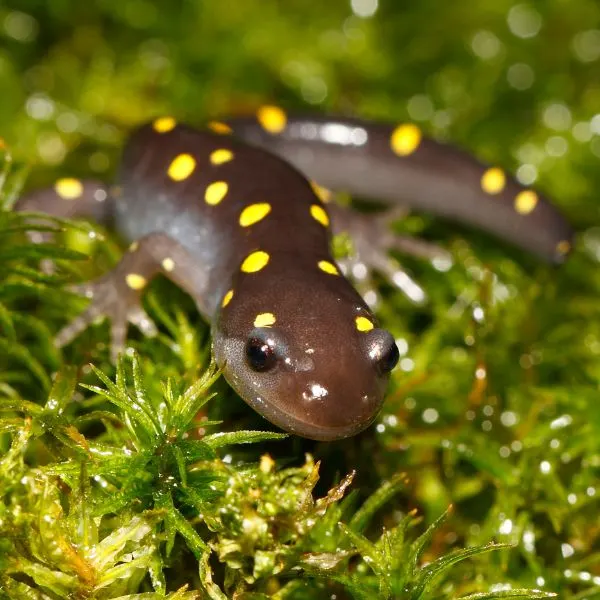
- BIonomial Nomenclature: Ambystoma maculatum
- Average Adult Size: 6 to 9.5 inches (15 to 24 cm)
- Life Span: 20 to 30 years
- Population Trend: Stable
- Conservation Statuses: S5 (Secure), Least Concern on IUCN
The spotted salamander is quite large. Unlike most salamanders, A. maculatum is stout instead of slender. A. maculatum is known as the spotted salamander because of the large orange or yellow spots on the dorsum (upper body). These spots are about 24 to 45. There are individuals without the spots but these are rare.
The species have a lifespan of 20 to 30 years with 20 years being the typical lifespan and 30 years being the range lifespan. The average lifespan of the species in captivity, according to Max Planck Institute for Demographic Research, is 25 years.
The spotted salamander occurs throughout most of eastern North America. This species is endemic to southern Canada including provinces in the east – Ontario, Quebec, New Brunswick, Prince Edward Island, and Nova Scotia.
In the United States, the species occur as far north as Maine. The range extends to Minnesota to the west and Texas and Georgia to the south.
Ambystoma maculatum occurs in mixed forests and hardwood. The species is always close to a vernal pond or a swamp. Adults can be found under soil surface objects such as logs and stumps. Others live in burrows. The adults come out during the breeding period.
Larvae live in ponds with no predaceous fish. The gravid females also lay eggs in ponds with no predaceous fish. On the Atlantic Coastal Plain, gravid females are known to lay eggs in backwater and sloughs that are accessible to predaceous fish that feed on the larvae.
3. Marbled Salamander
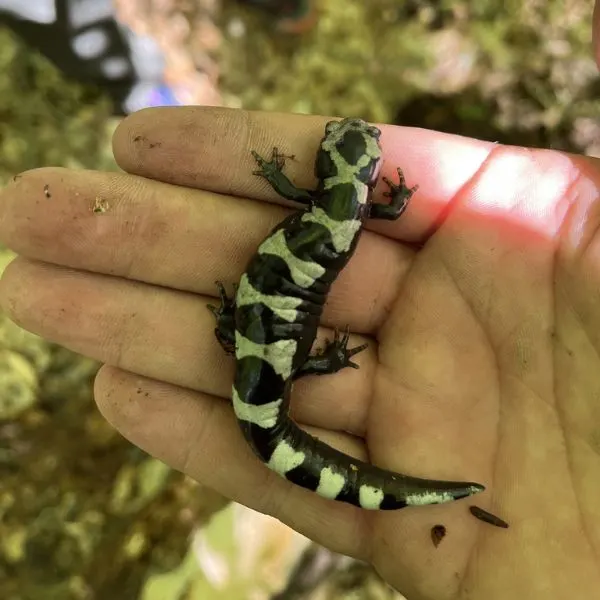
- BIonomial Nomenclature: Ambystoma opacum
- Average Adult Size: 3.5 to 4.25 inches (9 to 10.7 cm)
- Life Span: 3.5 to 4 years in captivity
- Population Trend: Stable
- Conservation Statuses: Least Concern on IUCN, S5 (Secure)
The marbled salamander has silvery white or silvery gray cross bands on a dark background. This coloration gives it a marbled appearance. Females are generally larger than males.
The species have a life span of 3.5 to 4 years in captivity.
The species’ geographic range starts as far north as southern New Hampshire and as far south as northern Florida and eastern Texas and the rest of the Gulf Coast. The species is mostly absent from the Appalachian Mountains. The species occurs in about 25 states.
Similar to other amphibians, the marbled salamander is endemic to a wide variety of woodlands. Regardless of the biome, the species is always close to a freshwater body such as a vernal pond or a swamp. The marbled salamander interestingly tolerates low humidity better than other salamanders and occurs in wooded sand dunes, and rocky slopes & bluffs.
Adults are terrestrial while larvae are aquatic.
4. Mole Salamander
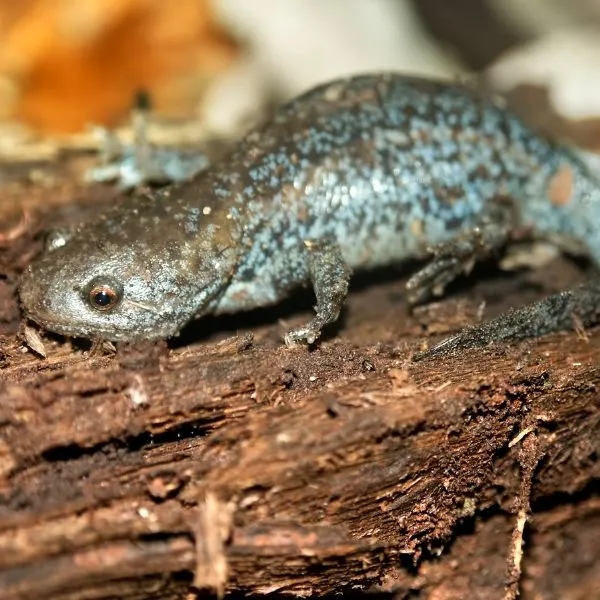
- BIonomial Nomenclature: Ambystoma talpoideum
- Average Adult Size: 3 to 4 inches (7.5 to 10 cm)
- Life Span: 10 to 20 years
- Conservation Statuses: Least Concern on IUCN Red List, S2 (Imperiled)
Even as adults, A. talpoideum is either aquatic or terrestrial. The terrestrial form resembles other terrestrial salamanders but the aquatic form resembles the larvae of other salamanders. This is because, in the aquatic form, the mole salamander never underwent a metamorphosis.
The body coloration of the species is gray to black with white flecks on the tail and back. The aquatic adults also known as neotenic adults have yellow ventral stripes and dark and light stripes on their undersides.
The species reaches a life span of 10 to 20 years in the wild.
The species is endemic from the Mississippi Valley to southern Indiana and Southern Illinois. Disjunct wild populations occur in Kentucky, Tennessee, Alabama, Georgia, North & South Carolina, and Virginia. The species is also endemic to Missouri. States in the geographic range not mentioned include Arkansas, Florida (probably), Louisiana, Mississippi, Oklahoma, and Texas.
The species inhabits woodlands close to breeding ponds. These include bottomland hardwood forests, pine Flatwoods, and floodplains. They occur in all types of forests throughout their range although they avoid clearcuts and open fields in South Carolina.
Adults can be aquatic or terrestrial. Terrestrial adults are those that metamorphose and aquatic adults are those that fail to metamorphose. Terrestrial adults live in burrows underground and under soil surface objects such as logs. They do this because they require moisture to thrive.
Aquatic adults live in ponds and other shallow freshwater bodies.
5. Small-Mouthed Salamander
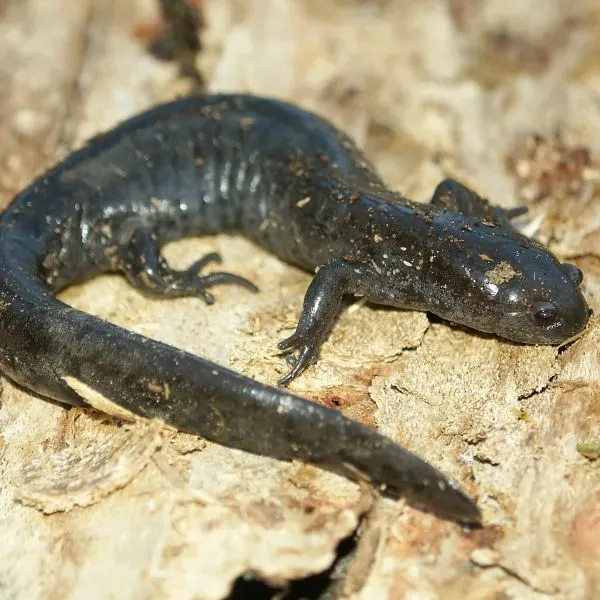
- BIonomial Nomenclature: Ambystoma texanum
- Adult Length: 4.3 to 7 inches (11 to 17.8 cm)
- Life Span: 5.3 years in captivity
- Population Trend: Stable
- Conservation Statuses: Least Concern on IUCN, S5 (Secure)
The small-mouthed salamander is known as such because of its small head and small mouth. The upper body of the species is black to gray with light blotches. These patterns disappear with age. The species have 14 to 16 costal grooves.
According to Max Planck Institute for Demographic Research, Ambystoma texanum has an average lifespan of 5.3 years in captivity.
The species is endemic to the Gulf Coast to southern Michigan in the United States. The species is also endemic to southern Ontario (Pelee Island) in Canada. The species can be found as far west as Nebraska and eastern Kansas. The species is also endemic to Missouri.
This amphibian inhabits a wide range of biomes. The species have been known to inhabit dense hardwood forests, oak woodlands, floodplain forests, moist pine woodlands, tall grass prairies, and even farmed areas.
The adults are generally underground in burrows or under logs, leaf litter, and rocks. They are found here because of the high moisture levels in these places.
The species breed in pools and ponds such as forest ponds, vernal pools, and seasonal pools. They even lay eggs in slow-moving portions of streams, and ditches.
6. Eastern Tiger Salamander
- BIonomial Nomenclature: Ambystoma tigrinum
- Adult Length: 7 to 13 inches (17 to 33 cm)
- Life Span: 10 to 25 years
- Population Trend: Stable
- Conservation Statuses: Least Concern on IUCN, S3 (Vulnerable)
The eastern tiger salamander has a yellow and black coloration which gives the amphibian its common name. This coloration also makes the species popular in the pet trade and relatively easy to identify.
The species have a captive lifespan of 10 to 25 years.
The species is endemic to most of North America. In Canada, the species occurs in Manitoba and possibly Ontario. In the United States, the species is endemic from Minnesota to Texas and from Maine to Washington. The only states the species is possibly absent from on the Mainland include California, Arizona, Idaho, and West Virginia.
While the total population is not known, it is estimated to be over a million.
The tiger salamander is quite versatile and can thrive in any habitat within its geographic range as far as there is a water body suitable for breeding close by and the soil is suitable for burrowing. They can also use burrows made by other animals such as small mammals.
Similar to other salamanders, this species generally prefer ponds without predaceous fish.
Family Plethodontidae
7. Longtail Salamander

- Binomial Nomenclature: Eurycea longicauda
- Common Names: longtail salamander
- Adult Size: 4 to 8 inches (10 to 20 cm)
- Population Trend: Stable
- Conservation Status: S5 (Secure)
Eurycea longicauda has a long tail which makes up about 60% of the species’ body length. The coloration of the species ranges from bronze to yellow.
Some individuals may have three lines on the back which run from along the body to the tail. These are known as three-lined salamanders (Eurycea guttolineata). This subspecies is also considered distinct species.
Some individuals have dark lines that run along their bodies. These are known as dark-sided salamanders (Eurycea longicauda melanopleura).
The longtail salamander is endemic to a huge portion of the eastern United States. The species can be found from Kansas and Missouri to southern new york to northwestern Virginia, western North carolina, northern Georgia, northern Alabama, northern Mississippi, Arkansas, and Tennessee.
The species is endemic to wooded habitats during the wet weather. They are otherwise endemic to caves, abandoned mines, spring runes, and streamsides. They may hide under leaf litter, logs, rocks, and in rock crevices.
The species is an invertivore and as such feeds mostly on invertebrates. Both larvae and adults feed on small invertebrates.
8. Cave Salamander

- BIonomial Nomenclature: Eurycea lucifuga
- Adult Length: 4.9 to 7.1 inches (12.5 to 18.1 cm)
- Life Span: 9.1 years
- Population Trend: Stable
- Conservation Status: S5 (Secure)
The coloration of Eurycea lucifuga is yellowish to reddish-orange. The underside is light yellow. Younger adults have duller coloration than older adults do. The cave salamander has a long tail that makes up about 50 to 70% of the total body length.
In captivity, the species is known to reach a life span of 9.1 years.
The species is an aquatic plethodontid salamander.
The species is endemic to a large portion of eastern North America. The species can be found from central Indiana to central Alabama and from northern Virginia to eastern Oklahoma.
The states that the species is endemic to include Kansas, Mississippi, Ohio, Oklahoma, West Virginia, Alabama, Arkansas, Georgia, Illinois, Indiana, Virginia, Kentucky, Missouri, and Tennessee.
The cave salamander usually inhabits limestone caves. Other habitats include wooded areas and fields; and rocky springs and streams. The species comes out in the open only when the weather is wet.
Otherwise, it hides under objects such as logs. Larvae live in cave pools and streams where females lay their eggs. The larvae live in these caves until their pools flow over. From there the larvae enter into larger streams.
The adults of the species feed on invertebrates. And as such is an invertivore.
9. Grotto Salamander
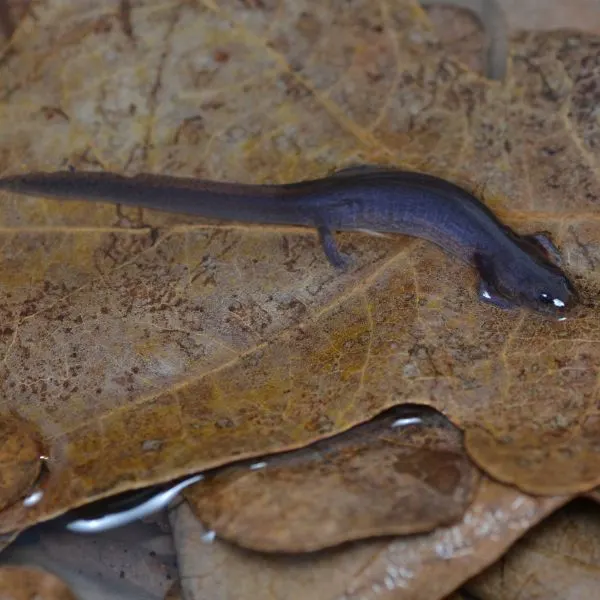
- BIonomial Nomenclature: Eurycea spelaea
- Adult Length: 3 to 5.3 inches (7.5 to 13.5 cm)
- Life Span: 12 years
- Population Trend: Unknown
- Conservation Status: S2S3 (Imperiled)
The species is a blind salamander and fully undergoes a metamorphosis. The species has a whitish dorsum (upper body) and ventrum. It is quite small and reaches a length of about 5 inches.
The lifespan of the species in captivity is about 12 years although the lifespan in the wild is unknown.
The species is endemic to the Ozark region of southwestern Missouri, southeastern Kansas, northwestern Arkansas, and northeastern Oklahoma where it inhabited caves and springs.
While the wild population of the species is unknown it is estimated to be more than ten thousand.
These species remain in aquatic larval form for about 2 to 3 years.
The adults live almost exclusively in caves. The larvae live in cave waters and surface spring runs. The species are usually found in caves with large bat populations.
10. Oklahoma Salamander
- BIonomial Nomenclature: Eurycea tynerensis
- Adult Length: 4.1 inches (10.5 cm)
- Life Span: at least 10 years
- Population Trend: Decreasing, IUCN Redlist
- Conservation Status: S4 (Apparently Secure)
This is a tiny salamander that reaches a length of 10.5 cm and has 19 to 20 costal grooves. The body is very elongated as well. Metamorphosed adults are brown in color. Neotenic adults, adults that didn’t undergo metamorphosis, are creamy white in coloration.
The species have been known to reach an age of 10 years.
The Oklahoma salamander is endemic to the Ozark Plateau in southwestern Missouri, northeastern Oklahoma, northern Arkansas, and southeastern Kansas.
The species inhabits spring-fed runs and streams with temperatures below 75 degrees Fahrenheit (24 degrees Celsius). They prefer cold fast-moving shallow waters. The substrate of the streams they inhabit is gravel, bedrock, or coarse sand. You can say that the species prefer gravelly substrates.
The species is an invertivore and feeds on subterranean isopods, mayflies, and chironomids (nonbiting midges or lake flies).
11. Four-toed Salamander
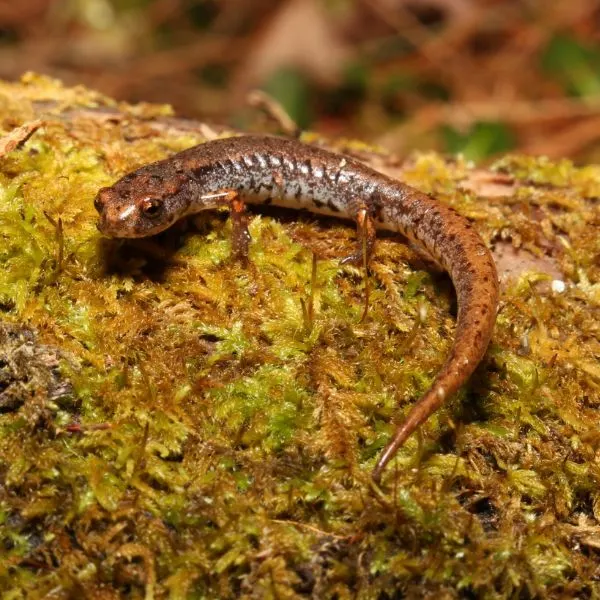
- Binomial Nomenclature: Hemidactylium scutatum
- Average Adult Size: 2 to 4 inches (5.1 to 10.2 cm)
- Life Span: 5.5 years
- Population Trend: Stable
- Conservation Status: S4 (Apparently Secure)
This is a small lungless salamander that can grow to a length of about 4 inches. The coloration of the species is brown with gray sides.
The four-toed salamander has four toes on their hind legs instead of five as most salamanders have. This characteristic gives the amphibian its common name. The species also have a ring about the tail.
The four-toed salamander has an average lifespan of 5.5 years. This is females in captivity.
The geographic range of the species spreads most of eastern North America. The species can be found in four provinces in Canada including Quebec. Ontario, New Brunswick, and Nova Scotia. It is endemic to the southern portions of Ontario and Quebec.
Within the united states, the species is endemic to almost every single state within the eastern United States as far as west as Oklahoma. The range goes as far south as Georgia and the Florida panhandle. The population of the species within its geographic range is discontinuous.
Although the total population is not known, it is estimated to be more than ten thousand but less than a million.
The species is generally found in wet wooded areas, wet open areas, boggy streams, and such. The species is never far from a freshwater body such as mossy or grassy pools, ponds, and the like. Adults of the species are terrestrial.
The species is an invertivore and feeds on aquatic and terrestrial invertebrates.
12. Western Slimy Salamander

- Bionomial Nomenclature: Plethodon albagula
- Adult Length: 4.8 to 6.8 inches (12 to 17 cm)
- Conservation Status: S5 (Secure)
This salamander is bluish-black to black. It is medium-sized and a woodland amphibian. On the body and tail of the western slimy salamander are several whitish flecks.
The species have 14 to 16 costal grooves.
The species is endemic to southern Missouri. Outside of Missouri, the species is endemic to the highlands of western and northern Arkansas, the Balcones Escarpment area of southcentral Texas, and the central portions of eastern Oklahoma.
The species are generally riparian. In Missouri, adults inhabit the underside of logs and rocks in wet wooded hillsides and ravines. During the summer when the weather is dry. The species is found in burrows underground or in caves. In Texas, the species is known to inhabit floodplains, wooded ravines, cave entrances, and along the shale banks of streams and rivers.
The species are active after rain or at night. During this time, they east small worms and arthropods. As such they are invertivores.
13. Ozark Zigzag Salamander
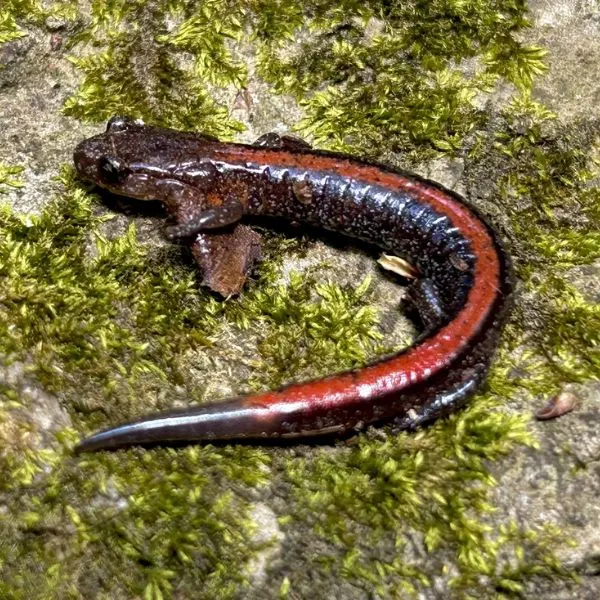
- Bionomial Nomenclature: Plethodon angusticlavius
- Adult length: 2.3 to 4 inches (5.8 to 10.2 cm)
- Population Trend: Stable
- Conservation Status: S3S4 (Vulnerable), Least Concern (https://www.iucnredlist.org/species/59329/118993270)
This is another woodland salamander. On the dorsum (upper body) is a stripe with wavy edges. This gives the salamander its common name. The stripe is orange, red, or yellowish the background color of the species is dark brown or black.
The species is endemic to the Ozark region of eastern Oklahoma, northern Arkansas, and southern Missouri. The species gets its common name from its geographic range and the zigzag pattern on its back.
The species hide under leaves, logs, and rocks at high. When nesting, the species use subterranean crevices and passages. The habitats the species live in include wooded slopes, caves, seepages, rubble, canyons, and ravines.
The species is an invertivore and feed on invertebrates.
14. Southern Red-backed Salamander

- BIonomial Nomenclature: Plethodon serratus
- Adult Length: 3 to 4 inches (8 to 10.5 cm)
- Population Trend: Stable
- Conservation Statuses: Least Concern on IUCN, S5 (Secure)
The red-backed salamander is known as the red back because of the distinct red stripe that runs down its back to the tip of the tail. The rest of the dorsum (upper body) is brownies with red pigmentation. The ventrum (underside) is gray.
Within Missouri, the species is endemic to the southeastern quarter. Other geographic isolates of the species include central Louisiana, eastern Alabama-Georgia-western North Carolina-easter Tennesse, and eastern Oklahoma-Arkansas.
Although the total population is not known, it is estimated to be more than ten thousand but less than a million.
The species is endemic to forest areas. Here they are found under mosses, logs, and rocks. When the weather is dry such as during the summer, they can be found in damp areas. They can also be found in twilight zones of caves.
The species feed on tiny vertebrates.
Family Proteidae
15. Mudpuppy
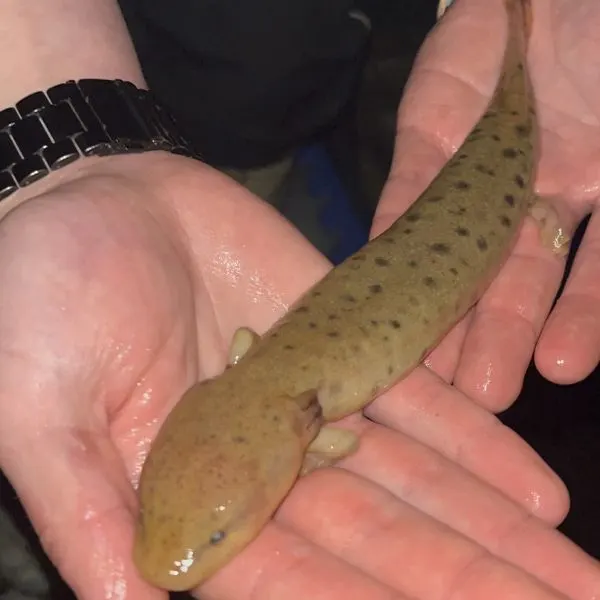
- BIonomial Nomenclature: Necturus maculosus
- Adult Length: 8 to 13 inches (20 to 33 cm)
- Population Trend: Stable
- Conservation Statuses: Least Concern on IUCN Red List, S4 (Apparently Secure)
This is a permanently aquatic salamander. The dorsum (upper body) of the mudpuppy is grayish brown and the underside is gray. It is covered in small dark spots. Even the underside may be covered in these spots. It has red gills and four toes on both its hindlegs and forelegs.
The species is endemic to most of eastern North America. In Canada, the species is endemic to Manitoba, Ontario, and Quebec. The species occur in the southern portion of its range in Canada.
Within the united states, the species is endemic to several states within the eastern United States. As far south as Georgia and as far west as Kansas.
This is an aquatic salamander and lives solely in freshwater.
16. Red River Mudpuppy
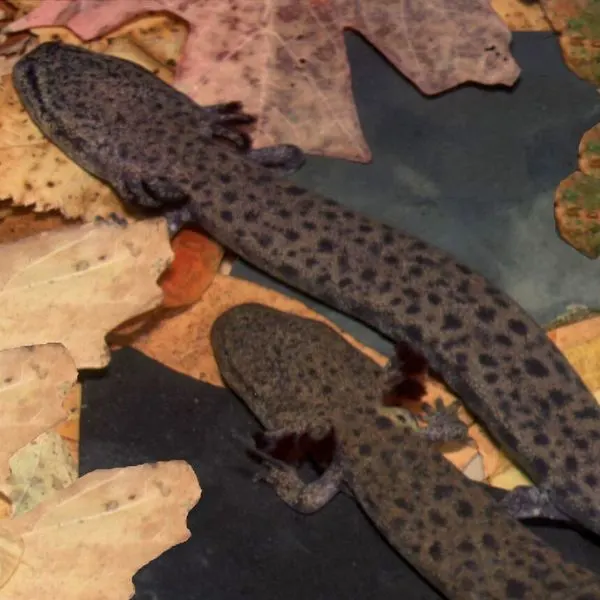
- BIonomial Nomenclature: Necturus louisianensis
- Population Trend: Stable
- Conservation Statuses: S4 (Apparently Secure)
The species is endemic to southern Missouri, eastern Oklahoma, southeastern Kansas, and northern Louisiana to Arkansas.
The species is aquatic. They are found in streams and other water bodies.
Family Cryptobranchidae
17. Hellbender

- Trinomial Nomenclature: Cryptobranchus alleganiensis bishopi & Cryptobranchus alleganiensis alleganiensis
- Adult Length: 11 to 23 inches
- Conservation Statuses: Near Threatened on the IUCN S1 (Critically Imperiled), Endangered under the U.S. Endangered Species Act
These are large aquatic salamanders. They have wide heads and tiny eyes. Their body and limbs are covered in folds of skin. The eastern hellbender is dark in coloration while the Ozark hellbender is light in coloration with several dark spots on the head and body.
Missouri is the only state with both the Ozark hellbender and the eastern hellbender.
Within southern Missouri and northern Arkansas, the subspecies Cryptobranchus alleganiensis bishopi is considered endangered under the U.S. Endangered Species Act.
The hellbender is a freshwater species. It inhabits rocky clear creeks and rivers. This species avoids water with temperatures above 68 degrees Fahrenheit (20 degrees Celsius).
Family Salamandridae
18. Eastern Newt
- Trinomial Nomenclature: Notophthalmus viridescens louisianensis
- Other Common Names: central newt
- Adult Length: 2.3 to 4.8 inches (5.8 to 12.2 cm)
- Eft Length: 1.5 to 3.5 inches (3.8 to 8.9 inches)
- Conservation Statuses: Least Concern on IUCN, S5 (Secure)
The central newt is a small aquatic salamander. As a newt, it has no costal grooves although it does have vertical grooves, the dorsum (upper body) of the adult central newt is dark in coloration while the belly is yellowish. As a eft, the newt is terrestrial. The coloration of the eft is reddish brown to dull brown or even cream.
This species is endemic to most of eastern North America. It occurs in Ontario, Quebec, New Brunswick, Prince Edwards Island, and Nova Scotia.
Within the United States, the range extends from Minnesota to eastern Kansas and to Texas.
The species is endemic to shallow waters. Larvae inhabit stream pools, swamps ponds, and lakes. So do adults. Efts may move to woodlands when overwintering. Adults may leave their aquatic habitat during fall or summer.
Frequently Asked Questions
Are Missouri salamanders poisonous?
The salamanders in Missouri are poisonous but the toxins they produce are mild in nature. This toxin gives them a horrible taste.
Is the mole salamander found in Missouri?
Yes, the mole salamander is endemic to Missouri. This salamander can be found in the extreme southeastern portion of Missouri. Aquatic adults live in ponds and other shallow freshwater bodies. Terrestrial adults live in burrows underground and under soil surface objects such as logs.
Where is the tiger salamander in Missouri?
The tiger salamander can be found throughout Missouri. The tiger salamander is quite versatile and can be found in most habitats within Missouri as far as there is a water body suitable for breeding nearby and the soil is suitable for burrowing.
Where in Missouri is the spotted salamander found?
The spotted salamander is located in the south to southeast of Missouri.
Spotted salamanders occur in mixed forests and hardwood. The species is always close to a vernal pond or a swamp. Adults can be found under soil surface objects such as logs and stumps. Others live in burrows. The adults come out during the breeding period.
Where is the hellbender found in Missouri?
The hellbender is endemic to southeastern to central Missouri. Hellbenders live in rocks clear creeks and rivers with temperatures below 68 degrees Fahrenheit (20 degrees Celsius).
Conclusion
There are about 20 species of salamanders listed in this article. While these salamanders for the most part resemble lizards, they are amphibians and are more closely related to frogs. Both have moist skins and undergo metamorphosis.
Similar to frogs, salamanders start lives fully aquatic. These are referred to as larvae and have gills with which they respire. Once they are adults, they lose their gills and breathe with their lungs. Some salamanders are lungless and respire through their skin.
Some salamanders also never lose their gills and are aquatic throughout their entire lifespan. An example of a lungless salamander is the longtail salamander alongside all the species of the family Plethodontidae. An example of a salamander that never loses its gills is the mudpuppy.
Other nearby states

